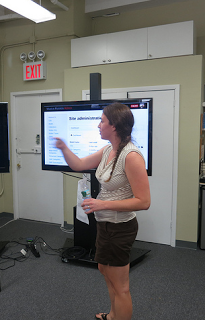Integration Experiences

Szymon Guz gave a talk which covered his experiences working for a large client on integrating an acquired business’ website and fulfillment processes into their existing backend and fulfillment systems.
He gave us a detailed overview of their existing shipping fulfillment infrastructure, along with specific technical issues he encountered when integrating with the fulfillment models of the additional website.
He also detailed some of the non-technical/project management challenges inherent when working with a large number of people on a project.
clients integration
Interesting jQuery Modules
Marina Lohova talked about her favorite jQuery modules. It was the last talk of the day and she did not have much time.
Her focus was on the functional plugins. Interesting modules that she mentioned include:
- Ajax PayPal Cart
- Sisyphus (uses HTML5 LocalStorage)
- jImpress (presentations)
- jPlayer (HTML5)
- ResponseJS
- lqTouch (adds mobile events like swipe)
javascript jquery
Liquid Galaxy NYC Annual Meeting
I’m here in NYC for End Point’s annual company meeting and I’m kicking off our live blogging! We hope to blog about several of the sessions during and throughout the company meeting to give you an idea of what we are sharing at the company meeting.
This first session is titled Liquid Galaxy past, present, and future. given by Ben. Liquid Galaxy is an immersive 360° Google Earth experience that has been leveraged for custom tours, GIS data, 3D models, and even video games. Here are a few of the things that Ben covered during his talk:
- past: Liquid Galaxy was created in 2009 as a Google 20% project and initially meant for enhancing Google Street View. With a few initial features, it picked up some momentum. Jason asked End Point if they would be interested in supporting Liquid Galaxy and Ben attended a conference to check it out. From there, End Point’s invested time and energy to build out the Liquid Galaxy side of the business and learned several valuable lessons during the initial installations. These lessons yielded improved technology for improved maintenance and support.
- present: The system is easier to deploy and has new features, such as a Google Earth tools, utilities for …
company conference visionport
Paper Source Client Profile
I know Richard best from his sysadmin work on End Point’s Hosting Team. But I also worked with him for our client Paper Source, covered by his presentation at our company meeting today.
Paper Source began in Chicago back in 1983. Since then they’ve opened more brick and mortar stores every year, now up to 54. End Point is now maintaining their e-commerce store, which supplements these well.
Richard and his team have integrated Interchange with many other software packages, including Adobe’s Scene7, Authorize.net, Great Plains, Endeca, and CoreMetrics. This adds up to many scheduled cron jobs every night. We also handle hosting of the production and Camps development servers.
clients
The Berkman Center projects
Brian Gadoury and his awesome socks gave a great and informative presentation on our client Berkman Center.
The Berkman Center’s mission is to explore and understand cyberspace; and to study its development, dynamics, norms and standards.
Brian’s first project was called Zone One that is a document repository tool that houses all of the electronic documents for use by Harvard. You can search by document name, tags, and content. Zone One is written using open source technologies such as Ruby on Rails, Postgres, Solr, and DevCamps.
The application includes an array of features that allow you to interact with the search results and the documents themselves. Each entry can have detailed meta-data associated with it, that can be referenced by future users.
One of the nice features of Zone One is its upload feature. It allows you to drag and drop files into a section the form for upload. The upload interface also includes a very nice SFTP system that utilizes virtual users on the system you are uploading to, to manage the files being uploaded and connected to the entry you are creating.
Phase two of the project will include features to export to external repositories, a bulk import …
camps clients rails
TriSano and Pentaho at our NYC company meeting
Josh Tolley just spoke to us about the TriSano open source project he works on. It helps track and report on public health events, using data at least partly gathered from doctors following special legal reporting requirements to look for epidemics.
A lot of this is about data warehousing. Public health officials collect a lot of data and want to easily report on it. Typically they use SPSS. Need to filter the data before doing analysis.
And what is a data warehouse? Store all your data in a different way that’s efficient for querying broken down by time (OLAP). Such queries don’t usually work very well in normal transactional (OLTP) database.
Dimension tables: E.g. different public health departments, sex, disease. Fact tables: Contains the numbers, facts that you may do math aggregation against, and links to dimension tables. The key to the whole process is deciding what you want to track.
Pentaho is what we use for the query interface. To get done what we need to do, we have to make use of unpublished APIs, using JRuby to interface between Pentaho (Java) and TriSano, a Rails app. Postgres is the database.
Brian Buchalter then took over and delved more into the TriSano Rails …
java open-source rails casepointer ruby development
Web service integration in PHP, jQuery, Perl and Interchange

Jeff Boes presented on one of his latest projects.
CityPass decided on a project to convert their checkout from being served by Interchange to have the interface served by PHP, but continue to interact with Interchange for the checkout process through a web service.
The original site was entirely served by Interchange, the client then took on a project to convert the frontend to PHP while leveraging Interchange for frontend logic such as pricing and shipping as well as for backend administration for order fulfillment.
Technologies used in the frontend rewrite:
- PHP
- jQuery for jStorage, back-button support and checkout business logic
- AJAX web services for prices, discounts, click-tracking
The Interchange handler is conduit.am that handles the processing of the URL. From this ActionMap the URLs are decoded and passed to a Perl module, Data.pm, which handles processing the input and returning the results.
An order is just a JSON object so testing of the web service is easy. We have a known hash, we post to the proper URL and compare the results and verify they are the same. New test cases are also easy, we can capture any order (JSON) to a log file and add it as a test case.
interchange javascript json perl php clients
Why Piggybak exists
There are some clients debating between using Spree, an e-commerce platform, and a homegrown Rails solution for an e-commerce application.
E-commerce platforms are monolithic—they try to solve a lot of different problems at once. Also, many of these e-commerce platforms frequently make premature decisions before getting active users on it. One way of making the features of a platform match up better to a user’s requirements is to get a minimal viable product out quick and grow features incrementally.
Piggybak was created by first trying to identify the most stable and consistent features of a shopping cart. Here are the various pieces of a cart to consider.
- Shipping
- Tax
- CMS Features
- Product Search
- Cart / Checkout
- Product Features
- Product Taxonomy
- Discount Sales
- Rights and Roles
What doesn’t vary? Cart & Checkout.
Shipping, tax, product catalog design, sales promotions, and rights and roles all vary across different e-commerce sites. The only strict commonality is the cart and the checkout.
Piggybak is just the cart and checkout.
You mount Piggybak as a gem into any Rails app, and can assign any object as a purchasable product using a the tag “acts_as_variant” and you’re …
ecommerce piggybak rails













